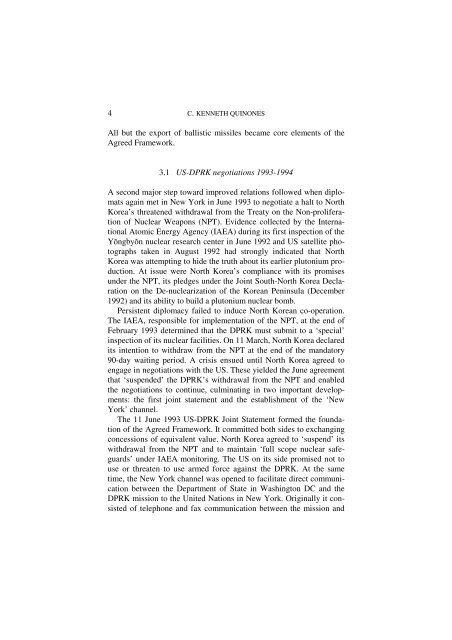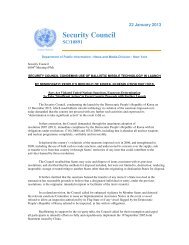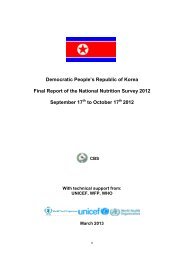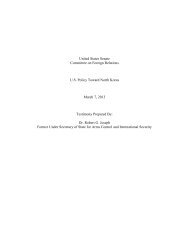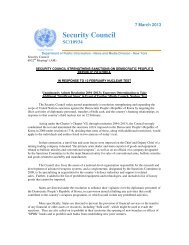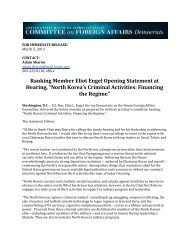Ken Quinones - National Committee on North Korea
Ken Quinones - National Committee on North Korea
Ken Quinones - National Committee on North Korea
Create successful ePaper yourself
Turn your PDF publications into a flip-book with our unique Google optimized e-Paper software.
4<br />
C. KENNETH QUINONES<br />
All but the export of ballistic missiles became core elements of the<br />
Agreed Framework.<br />
3.1 US-DPRK negotiati<strong>on</strong>s 1993-1994<br />
A sec<strong>on</strong>d major step toward improved relati<strong>on</strong>s followed when diplomats<br />
again met in New York in June 1993 to negotiate a halt to <strong>North</strong><br />
<strong>Korea</strong>’s threatened withdrawal from the Treaty <strong>on</strong> the N<strong>on</strong>-proliferati<strong>on</strong><br />
of Nuclear Weap<strong>on</strong>s (NPT). Evidence collected by the Internati<strong>on</strong>al<br />
Atomic Energy Agency (IAEA) during its first inspecti<strong>on</strong> of the<br />
Yŏngbyŏn nuclear research center in June 1992 and US satellite photographs<br />
taken in August 1992 had str<strong>on</strong>gly indicated that <strong>North</strong><br />
<strong>Korea</strong> was attempting to hide the truth about its earlier plut<strong>on</strong>ium producti<strong>on</strong>.<br />
At issue were <strong>North</strong> <strong>Korea</strong>’s compliance with its promises<br />
under the NPT, its pledges under the Joint South-<strong>North</strong> <strong>Korea</strong> Declarati<strong>on</strong><br />
<strong>on</strong> the De-nuclearizati<strong>on</strong> of the <strong>Korea</strong>n Peninsula (December<br />
1992) and its ability to build a plut<strong>on</strong>ium nuclear bomb.<br />
Persistent diplomacy failed to induce <strong>North</strong> <strong>Korea</strong>n co-operati<strong>on</strong>.<br />
The IAEA, resp<strong>on</strong>sible for implementati<strong>on</strong> of the NPT, at the end of<br />
February 1993 determined that the DPRK must submit to a ‘special’<br />
inspecti<strong>on</strong> of its nuclear facilities. On 11 March, <strong>North</strong> <strong>Korea</strong> declared<br />
its intenti<strong>on</strong> to withdraw from the NPT at the end of the mandatory<br />
90-day waiting period. A crisis ensued until <strong>North</strong> <strong>Korea</strong> agreed to<br />
engage in negotiati<strong>on</strong>s with the US. These yielded the June agreement<br />
that ‘suspended’ the DPRK’s withdrawal from the NPT and enabled<br />
the negotiati<strong>on</strong>s to c<strong>on</strong>tinue, culminating in two important developments:<br />
the first joint statement and the establishment of the ‘New<br />
York’ channel.<br />
The 11 June 1993 US-DPRK Joint Statement formed the foundati<strong>on</strong><br />
of the Agreed Framework. It committed both sides to exchanging<br />
c<strong>on</strong>cessi<strong>on</strong>s of equivalent value. <strong>North</strong> <strong>Korea</strong> agreed to ‘suspend’ its<br />
withdrawal from the NPT and to maintain ‘full scope nuclear safeguards’<br />
under IAEA m<strong>on</strong>itoring. The US <strong>on</strong> its side promised not to<br />
use or threaten to use armed force against the DPRK. At the same<br />
time, the New York channel was opened to facilitate direct communicati<strong>on</strong><br />
between the Department of State in Washingt<strong>on</strong> DC and the<br />
DPRK missi<strong>on</strong> to the United Nati<strong>on</strong>s in New York. Originally it c<strong>on</strong>sisted<br />
of teleph<strong>on</strong>e and fax communicati<strong>on</strong> between the missi<strong>on</strong> and


